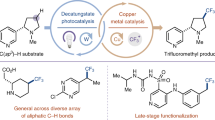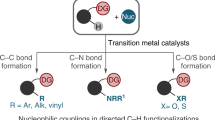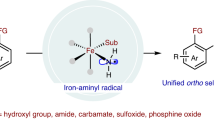Abstract
In directed C–H activation reactions, any nitrogen or sulphur atoms present in heterocyclic substrates will coordinate strongly with metal catalysts. This coordination, which can lead to catalyst poisoning or C–H functionalization at an undesired position, limits the application of C–H activation reactions in heterocycle-based drug discovery1,2,3,4,5, in which regard they have attracted much interest from pharmaceutical companies3,4,5. Here we report a robust and synthetically useful method that overcomes the complications associated with performing C–H functionalization reactions on heterocycles. Our approach employs a simple N-methoxy amide group, which serves as both a directing group and an anionic ligand that promotes the in situ generation of the reactive PdX2 (X = ArCONOMe) species from a Pd(0) source using air as the sole oxidant. In this way, the PdX2 species is localized near the target C–H bond, avoiding interference from any nitrogen or sulphur atoms present in the heterocyclic substrates. This reaction overrides the conventional positional selectivity patterns observed with substrates containing strongly coordinating heteroatoms, including nitrogen, sulphur and phosphorus. Thus, this operationally simple aerobic reaction demonstrates that it is possible to bypass a fundamental limitation that has long plagued applications of directed C–H activation in medicinal chemistry.
This is a preview of subscription content, access via your institution
Access options
Subscribe to this journal
Receive 51 print issues and online access
$199.00 per year
only $3.90 per issue
Buy this article
- Purchase on Springer Link
- Instant access to full article PDF
Prices may be subject to local taxes which are calculated during checkout




Similar content being viewed by others
References
Meanwell, N. A. Improving drug candidates by design: a focus on physicochemical properties as a means of improving compound disposition and safety. Chem. Res. Toxicol. 24, 1420–1456 (2011)
Ritchie, T. J., Macdonald, S. J. F., Young, R. J. & Pickett, S. D. The impact of aromatic ring count on compound developability: further insights by examining carbo- and hetero-aromatic and -aliphatic ring types. Drug Discov. Today 16, 164–171 (2011)
Schönherr, H. & Cernak, T. Profound methyl effects in drug discovery and a call for new C–H methylation reactions. Angew. Chem. Int. Edn Engl. 52, 12256–12267 (2013)
Bryan, M. C. et al. Sustainable practices in medicinal chemistry: current state and future directions. J. Med. Chem. 56, 6007–6021 (2013)
Davies, I. W. & Welch, C. J. Looking forward in pharmaceutical process chemistry. Science 325, 701–704 (2009)
Snieckus, V. Directed ortho metalation. Tertiary amide and O-carbamate directors in synthetic strategies for polysubstituted aromatics. Chem. Rev. 90, 879–933 (1990)
Kakiuchi, F. et al. Catalytic addition of aromatic carbon–hydrogen bonds to olefins with the aid of ruthenium complexes. Bull. Chem. Soc. Jpn 68, 62–83 (1995)
Jun, C.-H., Hong, J.-B. & Lee, D.-Y. Chelation-assisted hydroacylation. Synlett 1–12 (1999)
Colby, D. A., Bergman, R. G. & Ellman, J. A. Rhodium-catalyzed C–C bond formation via heteroatom-directed C–H bond activation. Chem. Rev. 110, 624–655 (2010)
Daugulis, O., Do, H.-Q. & Shabashov, D. Palladium- and copper-catalyzed arylation of carbon–hydrogen bonds. Acc. Chem. Res. 42, 1074–1086 (2009)
Lyons, T. W. & Sanford, M. S. Palladium-catalyzed ligand-directed C–H functionalization reactions. Chem. Rev. 110, 1147–1169 (2010)
Engle, K. M., Mei, T.-S., Wasa, M. & Yu, J.-Q. Weak coordination as a powerful means for developing broadly useful C–H functionalization reactions. Acc. Chem. Res. 45, 788–802 (2012)
Yeung, C. S. & Dong, V. M. Catalytic dehydrogenative cross-coupling: forming carbon-carbon bonds by oxidizing two carbon-hydrogen bonds. Chem. Rev. 111, 1215–1292 (2011)
Leow, D., Li, G., Mei, T.-S. & Yu, J.-Q. Activation of remote meta-C–H bonds assisted by an end-on template. Nature 486, 518–522 (2012)
Wasa, M., Worrell, B. T. & Yu, J.-Q. Pd(0)/PR3-catalyzed arylation of nicotinic acid and isonicotinic acid derivatives. Angew. Chem. Int. Edn Engl. 49, 1275–1277 (2010)
Ackermann, L. & Lygin, A. V. Ruthenium-catalyzed direct C–H bond arylations of heteroarenes. Org. Lett. 13, 3332–3335 (2011)
Cho, J.-Y., Iverson, C. N. & Smith, M. R., III Steric and chelate directing effects in aromatic borylation. J. Am. Chem. Soc. 122, 12868–12869 (2000)
Malik, H. A. et al. Non-directed allylic C–H acetoxylation in the presence of Lewis basic heterocycles. Chem. Sci. 5, 2352–2361 (2014)
Takagi, J., Sato, K., Hartwig, J. F., Ishiyama, T. & Miyaura, N. Iridium-catalyzed C–H coupling reaction of heteroaromatic compounds with bis(pinacolato)diboron: regioselective synthesis of heteroarylboronates. Tetrahedr. Lett. 43, 5649–5651 (2002)
Hurst, T. E. et al. Iridium-catalyzed C–H activation versus directed ortho metalation: complementary borylation of aromatics and heteroaromatics. Chemistry 16, 8155–8161 (2010)
Nakao, Y., Yamada, Y., Kashihara, N. & Hiyama, T. Selective C-4 alkylation of pyridine by nickel/Lewis acid catalysis. J. Am. Chem. Soc. 132, 13666–13668 (2010)
Tsai, C.-C. et al. Bimetallic nickel aluminum mediated para-selective alkenylation of pyridine: direct observation of η2, η1-pyridine Ni(0)−Al(III) intermediates prior to C−H bond activation. J. Am. Chem. Soc. 132, 11887–11889 (2010)
Kwak, J., Kim, M. & Chang, S. Rh(NHC)-catalyzed direct and selective arylation of quinolines at the 8-position. J. Am. Chem. Soc. 133, 3780–3783 (2011)
Wencel-Delord, J., Nimphius, C., Wang, H. & Glorius, F. Rhodium(III) and hexabromobenzene — a catalyst system for the cross-dehydrogenative coupling of simple arenes and heterocycles with arenes bearing directing groups. Angew. Chem. Int. Edn 51, 13001–13005 (2012)
Fu, H. Y., Chen, L. & Doucet, H. Phosphine-free palladium-catalyzed direct arylation of imidazo[1,2-a]pyridines with aryl bromides at low catalyst loading. J. Org. Chem. 77, 4473–4478 (2012)
Kuznetsov, A., Onishi, Y., Inamoto, Y. & Gevorgyan, V. Fused heteroaromatic dihydrosiloles: synthesis and double-fold modification. Org. Lett. 15, 2498–2501 (2013)
Wang, D.-H., Wasa, M., Giri, R. & Yu, J.-Q. Pd(II)-catalyzed cross-coupling of sp3 C–H bonds with sp2 and sp3 boronic acids using air as the oxidant. J. Am. Chem. Soc. 130, 7190–7191 (2008)
Campbell, A. N. & Stahl, S. S. Overcoming the “oxidant problem”: strategies to use O2 as the oxidant in organometallic C–H oxidation reactions catalyzed by Pd (and Cu). Acc. Chem. Res. 45, 851–863 (2012)
Lang, S. Unravelling the labyrinth of palladium-catalysed reactions involving isocyanides. Chem. Soc. Rev. 42, 4867–4880 (2013)
Ito, Y., Suginome, M., Matsuura, T. & Murakami, M. Palladium-catalyzed insertion of isocyanides into the silicon-silicon linkages of oligosilanes. J. Am. Chem. Soc. 113, 8899–8908 (1991)
Acknowledgements
We thank the following for financial support: the Shanghai Institute of Organic Chemistry, the Chinese Academy of Sciences, the CAS/SAFEA International Partnership Program for Creative Research Teams, the National Natural Science Foundation of China (grant NSFC-21121062), the Recruitment Program of Global Experts, the Scripps Research Institute and the NIH (NIGMS, 1R01 GM102265).
Author information
Authors and Affiliations
Contributions
Y.-J.L. and H.X. performed the reaction discovery experiments and contributed equally. W.-J.K., H.X. and M.S. performed the reactions with the heterocyclic substrates. H.-X.D. and J.-Q.Y. conceived the concept, directed the project and prepared this manuscript.
Corresponding authors
Ethics declarations
Competing interests
The authors declare no competing financial interests.
Supplementary information
Supplementary Information
This file contains Supplementary Text, Supplementary Methods, Supplementary Data and additional references - see Contents for details. (PDF 36081 kb)
Supplementary Data
This zipped file contains the 'cif' files for the X-ray crystallographic data for compounds: complex E, complex F, 3a, and 5i. (ZIP 98 kb)
Rights and permissions
About this article
Cite this article
Liu, YJ., Xu, H., Kong, WJ. et al. Overcoming the limitations of directed C–H functionalizations of heterocycles. Nature 515, 389–393 (2014). https://doi.org/10.1038/nature13885
Received:
Accepted:
Published:
Issue Date:
DOI: https://doi.org/10.1038/nature13885
This article is cited by
-
Expanding chemical space by para-C−H arylation of arenes
Nature Communications (2022)
-
A nickel phosphide nanoalloy catalyst for the C-3 alkylation of oxindoles with alcohols
Scientific Reports (2021)
-
Late-stage C–H functionalization offers new opportunities in drug discovery
Nature Reviews Chemistry (2021)
-
Selective Aerobic Oxidation of Secondary C (sp3)-H Bonds with NHPI/CAN Catalytic System
Catalysis Letters (2021)
-
Molecular basis for the P450-catalyzed C–N bond formation in indolactam biosynthesis
Nature Chemical Biology (2019)
Comments
By submitting a comment you agree to abide by our Terms and Community Guidelines. If you find something abusive or that does not comply with our terms or guidelines please flag it as inappropriate.



